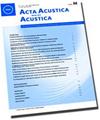Rippled Depth Thresholds: Estimates Obtained by Discrimination From Rippled and Nonrippled Reference Signals
Q1 Arts and Humanities
引用次数: 2
Abstract
The objective of the study was to better understand of contribution of excitation-pattern and temporal-processing mechanisms of frequency analysis to discrimination of complex-spectrum signals in various discrimination tasks. Using rippled-spectrum signals, the ripple depth thresholds were measured as functions of ripple density under conditions of rippled or non-rippled reference signals. With rippled reference signals, the ripple depth thresholds were as low as 0.11 at low ripple densities (2–3 cycles/oct) and rose to 1.0 at a ripple density of 8.9 cycles/oct. For non-rippled reference signals, ripple depth thresholds were nearly the same as for rippled reference signals at ripple densities of up to 7 cycles/oct; at ripple densities of 10 cycles/oct and higher, ripple depth thresholds rose slowly and reached 1.0 at a ripple density of 26 cycles/oct. The results hypothetically suggest contributions of the excitation-pattern processing and temporal-processing mechanisms of frequency analysis to discrimination of rippled signals. The excitation-pattern mechanism featured low depth thresholds at low ripple densities but could not function at ripple densities above 10 cycles/oct. The temporal-processing mechanism manifested at higher ripple densities and non-rippled reference stimuli.波纹深度阈值:由波纹和非波纹参考信号判别得到的估计值
本研究的目的是为了更好地了解频率分析的激励模式和时间处理机制对各种识别任务中复杂频谱信号识别的贡献。利用纹波频谱信号,在参考信号有纹波或无纹波的情况下,测量纹波深度阈值作为纹波密度的函数。当参考信号呈纹波时,低纹波密度(2-3个周期/oct)时,纹波深度阈值低至0.11,而当纹波密度为8.9个周期/oct时,纹波深度阈值上升至1.0。对于非纹波参考信号,纹波深度阈值与纹波参考信号在纹波密度高达7 cycles/oct时几乎相同;当纹波密度为10 cycles/oct及以上时,纹波深度阈值上升缓慢,当纹波密度为26 cycles/oct时达到1.0。研究结果假设了频率分析的激励模式处理和时间处理机制对纹波信号的识别的贡献。在低纹波密度下,激发模式机制具有较低的深度阈值,但在纹波密度大于10 cycles/oct时则无法发挥作用。时间加工机制在高纹波密度和非纹波参考刺激下表现出来。
本文章由计算机程序翻译,如有差异,请以英文原文为准。
求助全文
约1分钟内获得全文
求助全文
来源期刊
CiteScore
2.60
自引率
0.00%
发文量
0
审稿时长
6.8 months
期刊介绍:
Cessation. Acta Acustica united with Acustica (Acta Acust united Ac), was published together with the European Acoustics Association (EAA). It was an international, peer-reviewed journal on acoustics. It published original articles on all subjects in the field of acoustics, such as
• General Linear Acoustics, • Nonlinear Acoustics, Macrosonics, • Aeroacoustics, • Atmospheric Sound, • Underwater Sound, • Ultrasonics, • Physical Acoustics, • Structural Acoustics, • Noise Control, • Active Control, • Environmental Noise, • Building Acoustics, • Room Acoustics, • Acoustic Materials and Metamaterials, • Audio Signal Processing and Transducers, • Computational and Numerical Acoustics, • Hearing, Audiology and Psychoacoustics, • Speech,
• Musical Acoustics, • Virtual Acoustics, • Auditory Quality of Systems, • Animal Bioacoustics, • History of Acoustics.

 求助内容:
求助内容: 应助结果提醒方式:
应助结果提醒方式:


